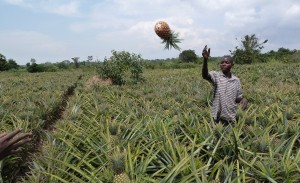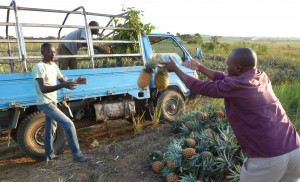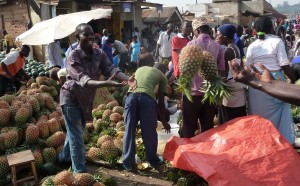By Katharine Troeger, University of Kassel, Department of Agricultural Engineering, Germany / DITSL – German Institute for Tropical and Subtropical Agriculture, Witzenhausen, Germany
This post is part of the ADM Institute’s #PreventPHL blog campaign, following up on the First International Congress on Postharvest Loss Prevention. To read more posts in the series, click here.
When you buy a fresh pineapple from any of the markets or roadside vendors in Kampala, you can be quite certain that the fruit has already passed through numerous hands. From harvest to sale, people do their best to bring the fruits as quickly as possible to the consumers and this means that the fruits are often literally thrown from the field to the loading place, onto the truck, off the truck and in the markets. As part of the “Reduction of Post-Harvest Losses and Value Addition in East African Food Value Chains” Project (RELOAD)*, my goal in Uganda was to learn about existing losses in pineapple value chains and potential for improvement with an emphasis on how people along the chain manage the given conditions. With this at the forefront of my mind, I pondered the significance of these “flying pineapples”.
Observations left me with a puzzle: despite reports of tremendous losses and waste, my observations in markets and interactions with pineapple growers and traders left me with a conundrum. The bruising and damage inflicted on the pineapples as a result of the throwing was clearly a loss in terms of quality. However, this occurred in a context in which the idea of wasting and throwing away such precious fruits did not seem acceptable, and in practice, was rarely done. Even small blemished fruits that no longer had the appearance of being fresh were still brought to markets and put to use. Vendors sold these fruits at low prices with little profit, and in the process made this nutritious food more accessible to poor people. This is an important food security angle from which to consider postharvest losses.
Orientation towards higher value and better quality often seems desirable. However, making un-contextualized recommendations to reduce losses and improve quality through better handling, packaging, and storage doesn’t adequately account for the complexity of social and ecological forces influencing the whole chain. There are many inter-related factors to consider as part of the broader system. For example, are there sufficient resources available to minimize losses and to what extent, and how would this change accessibility to food? If only standardized and high-quality fruits are available in the markets, who might no longer be able to purchase pineapples? Although selling fruits in stalls along the side of the street may not be ideal for maintaining the freshness of perishable fruits, it is convenient for consumers who want to purchase a ready-to-eat healthy food. Therefore, not only the monetary costs to implement and enforce a quality infrastructure are relevant. We must ask who would lose and who would win from such interventions? Some of these thoughts relate to what is discussed, for instance, in Rutten 2013 and Costa and Caixeta 1996. Generally, losses are not linked only to farmers but rather to multiple actors both in the respective chains and in a given society.
Thus can we, as researchers and policy-makers, really understand the problem without integrating the perspective of those directly involved in the chain – through participating in problem definition and the process of addressing it? What are all of the interlinked causes and effects of losses? How might efforts to reduce postharvest losses and improve marketed quality affect different people? A systems perspective can offer a road map for post-harvest loss reduction. How can the existing knowledge of people whose activities comprise systems be integrated for improved benefits? With a multi-actor and multi-scalar approach, strategies need to consider and counterbalance potential negative effects and encourage local and context-specific solutions.
Dialogue initiated at the First International Congress on Postharvest Loss Prevention began the process of addressing the complexity of post-harvest topics between different countries and on various political levels. It is long overdue to come together as a community to share and integrate knowledge in search of sustainable solutions. Discussions and sharing of experiences need to continue.
* Reduction of Post-Harvest Losses and Value Addition in East African Food Value Chains (RELOAD), of the Securing the Global Food Supply (GlobE) Initiative of the German Federal Ministry for Education and Research (BMBF) in cooperation with the German Federal Ministry for Economic Development
The blog entries in this #PreventPHL series are by students and members of the PHL Prevention community of practice. The opinions expressed are those of the individual authors and do not necessarily reflect the position of the ADM Institute. In addition, none of the statements should be considered an endorsement of any person, product, or technique by the ADM Institute.





Interesting article. I agree it a complex issue to solve economically,…perharps local and context-specific solutions would work… I am an African (Nigerian to be specific living in the US) and we also face this same post havest issues from what i remember growing. It happens to other crops like Yams, potatoes, manoges, etc..it’s a general issue. I hope developing countries can learn/get help quicker in this 21st century.
Thank you Katharine Troeger, University of Kassel, Department of Agricultural Engineering – German Institute for Tropical and Subtropical Agriculture for the post discussing the context of Flying Pineapple,
Could hidden protocol fees and services explain why “those directly involved in the chain” see no incentive to “participate in problem definition” or implement transparent “process of addressing it”?
Consider a similar conundrum, not about bruising… but across to the grain field about “Low birth rates, growth faltering and stunting” described by Dr. Cardwell (2015)
“Farmers whose scale of operation is too small to be able to produce SAFE FOOD, are too small to farm maize (or any aflatoxin sensitive staple)” who is the National Program Leader, National Institute of Food and Agriculture, USDA.
Thank you ADMI for the chance to comment,
William Lanier
Reference
Cardwell, K. (2015, April). Aflatoxin Identifying the Way Forward [TOPS Presentation].
Retrieved .